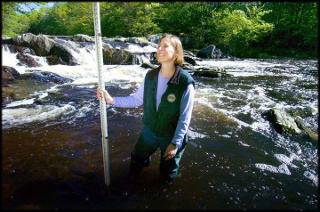Phases of the Moon, the newsletter of the Maine NVC Network
Issue Five: Building the Culture of Peace Within
Our newsletter appears once a month around the time of the new moon. Our purpose is to contribute to the NVC learning of people who have taken at least an NVC Level 1 workshop, and help us stay connected as we endeavor to deepen a culture of peace within ourselves, our families and the world. We believe a Level 1 offers so many new ways of thinking that additional support for learning and integration could be helpful.
We endeavor to make each edition informative, connecting, inspiring and fun. Please let us know how the newsletter might contribute to your NVC well-being.
The theme for this issue is Building the Culture of Peace Within: how to know if we are using NVC to try and get our way or if we have shifted to a place of internal peace where authentic connection grows.
Contents

|
What’s In a Name?
by Peggy Smith, CNVC certified NVC trainer
NVC stands for Nonviolent Communication. People often ask, "Why use the word nonviolent?" Can’t we name what it IS rather than what it is not?
At those times, I enjoy remembering how Mahatma Gandhi defined violence: When I make myself or the other person wrong in my own thinking - that is the seed of violence.
If we want to shift our personal responses and our entire culture to one of peace, the transformation begins in the ways we think. For outer change to be sustainable, inner change is essential. NVC gives specific processes for looking deeply into the ways I judge myself and others, and using NVC I am able to see those judgmental thoughts not as faults (more self blame) but as signals that can lead me to deeply held values.
My judgments have the potential of helping me connect more and more deeply to the universal human needs that flow within me. I use the classical NVC form —Observation, Feelings, Needs, Requests (OFNR)—within my own mind long before I consider using it aloud with another person. That’s why I often say that NVC is 90 percent an "inside" job.
So while we often think of NVC as a different form of communicating, I have found it more effective to conceive of it as a different pattern of thinking. When my thinking patterns change, then my language follows with less effort and more aliveness. I imagine that I also don’t end up sounding to others like a strange alien talking in a stilted way. (Well, I probably do still sound a bit strange much of the time… but that’s another story.)
This internal journey often includes these parts:
- Seeking out those seeds of violence (blame and judgment) in my thinking
- Accepting them as signals that parts of myself want expression
- Inviting myself to embrace these parts with openness
- And, if these blaming/judging parts of myself are strong, taking time to do self-empathy and/or be held in empathy by another
Sometimes the shift from unconscious reaction to self-awareness is quick. Other times it can take days of patiently accepting and accompanying my stormy thoughts with kind attention before a sustainable shift happens within me.
Before the shift is complete I find I often have a "clear and firm" sense of "who is at fault," myself or the other person. During this time, I often experience an urgency to express the Observation, Feelings, Needs, Request script that I have rehearsed over and over in my mind. I find that my intention in using OFNR sometimes can be to release unpleasant pressure within myself or to educate the other person about how he or she ought to behave so that I don’t suffer in the future.
|
When the shift to self-connection has occurred there is a noticeable change in my body. I often drop into "baby" breathing: the breath is deep and expands my back and sides, as well as my lower belly. Taking time to check to see if "baby breathing" is present will provide an indication that a shift has occurred. Another indication of a completed shift is calmness about expressing. When I have arrived at a place of presence there is no longer an urgency within me to express what is going on inside of me. It’s not that I don’t want to express what is authentically alive in me, what is different is the level of urgency I experience about that expression. When the urgency is gone and the baby breathing is there, I find speaking (or even emailing) is powerful and peaceful. For me, NVC is a strategy to shift my deep habits of blame and judgmental thinking to needs-based thinking, thereby contributing to the needs of connection, authentic harmony, authenticity, acceptance, community and eventually peace. Authors gratitude: I want to express my appreciation for all the NVC trainers who have influenced my journey, particularly Marshall Rosenberg, Gina Cenciose, and the NVC Training Institute; also to Dan Miller, the human potential trainer, whose ideas and support have greatly contributed to this article. Peggy Smith is co-founder of the Maine NVC Network and founder/principle trainer with Open Communication Have a question about how to apply NVC in your own life? Ask the Giraffe |
Ideas for Practice
|
~ ~ ~ ~ ~ ~ ~ ~ ~ ~ ~ ~ ~ ~ ~ ~ ~ ~ ~ ~ ~ ~ ~ ~ ~ ~ ~ ~ ~ ~ ~ ~
~ ~ ~ ~ ~ ~ ~ ~ ~ ~ ~ ~ ~ ~ ~ ~ ~ ~ ~ ~ ~ ~ ~ ~ ~ ~ ~ ~ ~ ~ ~ ~
Crossword PuzzleThis is a fully interactive online puzzle; we will have a new one each month which relates to the issue's theme. Upcoming TrainingsMay 22, Belfast, ME
|
Book Review:
|
July 7 thru August 4, Monday and Wednesday evenings
PAX 495: Sustainable Communication:
Theory & Practice of Nonviolent Communication
UM Hutchinson Center, Belfast, ME
This is a 3 credit course, equivalent to a combined Level 1 & Level 2 workshop; a wonderful opportunity for students, teachers, social workers,
health care professionals and other professionals who require credits for
re-certification to experience the power and delight of shifting our thinking to
needs-based consciousness. This course will also be helpful to parents or
business professionals who want to explore how needs-based consciousness will
enhance connection and expand creativity. Course taught by Peggy Smith, CNVC
certified trainer
For questions about course content please contact Peggy Smith: 789-5299 or email
To register or call 338-8000


